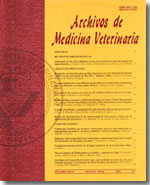A new liquid medium for the pathogen Piscirickettsia salmonis
Main Article Content
Abstract
Piscirickettsia salmonis is the ethiologic agent of the Salmonid Rickettsial Syndrome (SRS), which was first described in cultured Coho salmon in the south coast of Chile in 1989 and since then has been reported in different places around the world. Initially, this bacterium was described as an obligate intracellular pathogen, able to grow only in cytoplasmic vacuoles in host cell where it replicates by binary fission, so their in vitro culture is performed mainly in cell lines derived from fish. Recently, it has been demonstrated that this bacterium can grow in cell-free media containing sheep blood or fish and high levels of cysteine; however, due to the presence of cellular elements these culture media present drawbacks regarding handling, storage and high costs. We propose an artificial culture medium supplemented with an iron salt to replace the blood that is traditionally used; it reported successful growth of the bacterial reference strain and of a strain isolated from the environment, which was evaluated by optical density (OD600), while purity and identity of the culture were checked by using Gram stain, immunofluorescence and PCR. Developing a blood-free culture medium facilitates the cultivation of P. salmonis and allows the growth of this bacterium in a liquid medium, which provides various microbiological and biotechnological applications.

